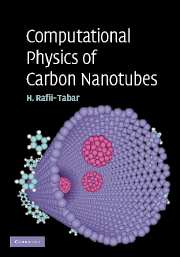Book contents
- Frontmatter
- Contents
- Preface
- 1 Introduction
- Part I
- 2 Formation of carbon allotropes
- 3 Nanoscale numerical simulation techniques
- 4 Interatomic potentials and force-fields in the computational physics of carbon nanotubes
- 5 Continuum elasticity theories for modelling the mechanical properties of nanotubes
- 6 Atomistic theories of mechanical properties
- 7 Theories for modelling thermal transport in nanotubes
- Part II
- References
- Index
6 - Atomistic theories of mechanical properties
Published online by Cambridge University Press: 29 September 2009
- Frontmatter
- Contents
- Preface
- 1 Introduction
- Part I
- 2 Formation of carbon allotropes
- 3 Nanoscale numerical simulation techniques
- 4 Interatomic potentials and force-fields in the computational physics of carbon nanotubes
- 5 Continuum elasticity theories for modelling the mechanical properties of nanotubes
- 6 Atomistic theories of mechanical properties
- 7 Theories for modelling thermal transport in nanotubes
- Part II
- References
- Index
Summary
Information concerning the mechanical properties of nanostructures, such as their elastic constants, fracture strength, stress distribution maps, etc., can be obtained directly from the underlying interatomic potential energies. Here, we consider the necessary theoretical tools for the atomistic-based computation of these properties, and show in detail the steps that could be followed to derive the analytical expressions that can be used in computer-based simulations. We assume that the energetics of an N-atom system, as described by an interatomic potential energy function of whatever variety, are known. However, we illustrate our derivations on the basis of central two-body potentials. Derivation of these properties, based on more complex many-body potentials, can follow similar techniques to those discussed here for the two-body potentials. A concise derivation of the pertinent expressions for the atomic-level stress tensor and elastic constants is very desirable, and this task has been performed in the work of Nishioka et al., to which we shall refer.
Atomic-level stress tensor
The notion of obtaining the elastic constants and atomic-level stresses of a crystal in terms of interatomic forces was extensively studied by Max Born in his classic treatise with Huang using the method of small homogeneous deformations. Let us, as before, denote the stress by the rank-two tensor σαβ(i), where the index i is now introduced to designate a particular atom in an N-atom system, and α, β = 1, 2, 3 refer to the x1-,x2- and x3-Cartesian components.
- Type
- Chapter
- Information
- Computational Physics of Carbon Nanotubes , pp. 186 - 194Publisher: Cambridge University PressPrint publication year: 2007



